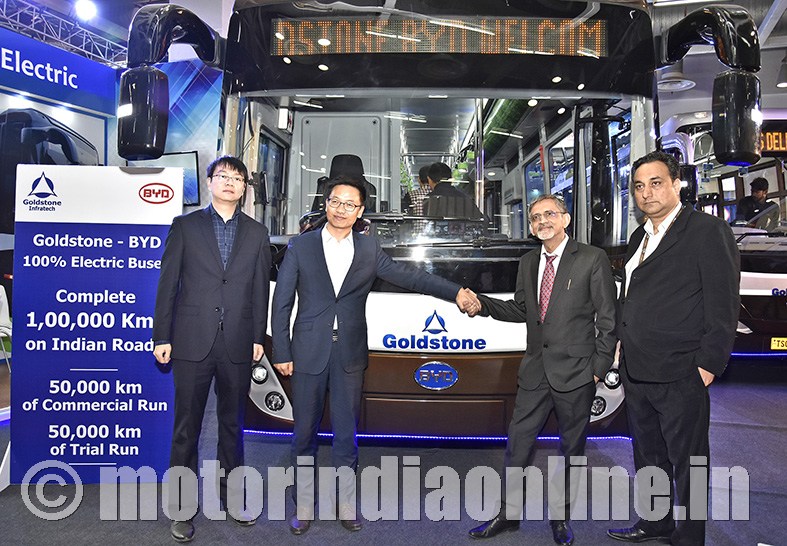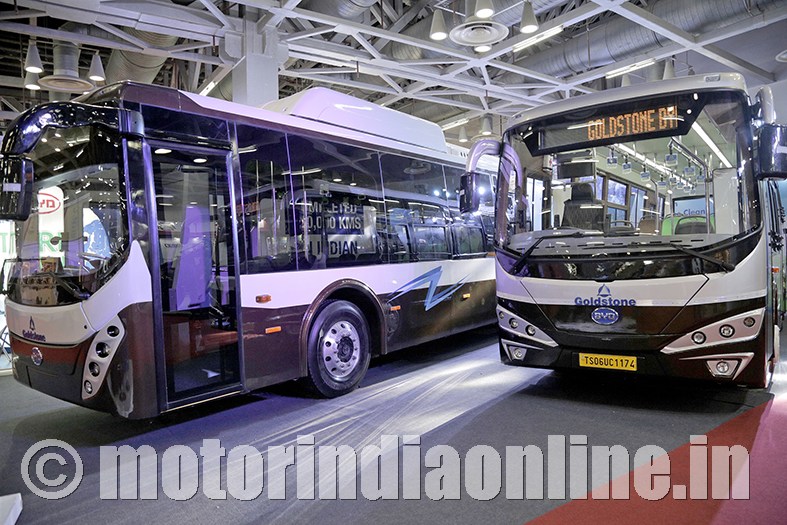Vehicles locally built in partnership with MG Group
If all the Indian bus manufacturers present at the 2018 Auto Expo were keen to showcase their latest electric vehicles, Goldstone Infratech is probably to be blamed! Jimmying the first-mover advantage in terms of battery-electric buses in India, the Hyderabad-based company is surging ahead in the market race for affordable zero-emission bus transport, even when the race isn’t clear-cut for many other bus makers yet.

Goldstone entered into an agreement with the China-based BYD Auto sometime in late 2016, spent the entire next year in field trials of imported electric bus prototypes at various centres across the country, and now back with locally-designed and built production versions that are up for grabs. I forgot to mention that Goldstone’s new buses are already inducted in the only two STUs that use emission-free buses in the country – HRTC and BEST – for commercial public operations.
Mr. N.K. Rawal, Managing Director, Goldstone, couldn’t be more pleased with the way things are unfolding with regard to electric buses in India. “We are working on these buses for more than a year, now deliveries have begun, orders are pouring in, and the acceptance of e-buses in the market is greatly improving”, he says, and adds that the future prospects for e-bus manufacturing in India are phenomenal and lot of consolidation is expected to happen in an year or so. About 10 potential buyers are bidding for an order of about 350 buses right this month (February), he exclaims.
The new Goldstone K7 and K9 buses still underpin the international BYD chassis and platform, but the bus body is fully-designed in-house as per the Indian standards and operational requirements. “The new models are Indian bus code and UBS II compliant and have been thoughtfully designed for local nitty-gritties, including aisle and legroom space, seating, material quality, etc., with a great deal of locally-sourced components except for the electric powertrain and battery pack”, explains Mr. Rawal.
What is the level of localization for these buses? “As of now, it is increasing gradually every week, as a lot of local sourcing and validation of aggregates is under process. By this year end, cell-level assembly of battery pack is also expected to kick-start in our local facility, with imported battery cells from China”, says the MD.
But he also warns that localization does not always mean reduction in price of the final product. Product costs of EVs are greatly determined by their manufacturing ecosystem including availability of components and technology, which in India’s case is yet to develop.
Goldstone is gearing up its manufacturing facility to assemble over 300 buses an year, including an in-house bus body building infrastructure. BYD Auto’s technical teams assist the assembly and supervise quality and other technicalities, especially with respect to battery, electric motors and controllers. The company also aids its clients in designing and erecting appropriate charging infrastructure for hassle-free operation of electric buses.
“Selling electric buses means trading a whole new ecosystem, as customers are largely incapable and indifferent to EV technologies. Especially in STUs, the existing technician workforce is not qualified enough to maintain high-voltage electric systems in these buses. Therefore, we as OEM have to take care of the entire spectrum. We also offer lifetime AMCs to STUs, set up our service centers at their depots and conduct necessary training to their personnel,” he adds.
With more and more OEMs entering the electric buses segment in India, Goldstone feels that availability of competitive products will kindle customer demand for the EVs organically, and help expand the ecosystem for battery-electric buses in the country. “The e-bus market is entirely government policy-driven at least for now. Therefore, sustenance through subsidy for electric vehicles is necessary to kickstart sales. Yet, we are also positive that Indian bus operators are well aware of the long-term frugality of operating electric buses that also offer better comfort and safety levels. They are willing to pay extra penny for the greater good”, Mr. Rawal observes.
New Goldstone K7 and K9: ‘Enhanced Appeal’
Design wise, the new K7 and K9 buses are chiselled to appear more bulbous and spacious with large glass side panels, providing an airy and bright ambience inside. The K7 can seat 31 passengers and the longer K9 can seat 39 commuters, excluding the driver. The latter is equipped with reclining-type seats aimed at comfy sub-urban operations.
For the driver, the seat is multi-way adjustable, steering wheel is multi-functional with buttons, and the instrumentation cluster hosts a digital information display. The other features include remote smart keys, hand-held ticket-vending machine connected to the intelligent bus management system with telematics and infotainment features, and an easy-to-operate push-button gear selector.
The front and rear axles of both the buses are air-suspended, while all the four wheels are equipped with disc brakes assisted by ABS technology. Goldstone claims that the K7 can drive up to 200 km on full charge, with a charging duration of 2-3 hours. The K9, on the other hand, extends a driving range of 250 km, while taking 4-5 hours to replenish the battery pack.
In fact, Goldstone’s tech partner BYD understands the EV battery like no other. Its core competency lies in its own battery design and technology – Iron phosphate (Fe) type Li-ion – that is acclaimed as ultra-efficient and safe to use.
